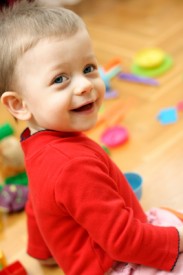 Between two and three years of age your child will learn and use almost a thousand new words and learn the rudiments of grammar. By the end of this year she will be able to speak in short sentences, use pronouns like “me”, “you”, and “mine” and even start using a few adverbs like “fast” and “slow”.
Between two and three years of age your child will learn and use almost a thousand new words and learn the rudiments of grammar. By the end of this year she will be able to speak in short sentences, use pronouns like “me”, “you”, and “mine” and even start using a few adverbs like “fast” and “slow”.
The brain of a two-year-old is remarkable – it is a pattern analyzer and predictor. Your child can hear a string of words that have no audible break in them, like “Ihearyou” and parse the sentence into three words, logically figuring out that the second word is “hear” even if he has never been exposed to the word “hear” before. If you say “Iseeyou” it might be a little more difficult for your child to determine whether you said “icy you” or I see you” because in English we have many words that end in the “s” sound. But we have no words that end in “h”, (“Ih ear” you is impossible in English) and your two-year-old’s brain has figured that out. My daughter Heather around two responded to my plea “Heather, please behave” with “I’m have-ing” mommy”, because she misinterpreted this knowledge to assume “behave” was two words, “be” and “have”, as in “be good”. But for the most part, this ability to statistically figure out where one word ends and the other begins will help your child figure out not just vocabulary, but grammar as well.
The language learning mechanism that cultures around the world have developed to assist this statistical learning of language by two-year-olds is “nursery rhymes”. Linguists will tell you that almost all cultures and languages have nursery rhymes that are told and repeated to two to three-year-old children. Nature, through our adult mirror neuron system, has provided an intuitive mechanism to help our young children figure out the syllable structure and phonological (sound combination) rules of their native language so that during the second year of life a child can master 900 new words in their native language. Keep in mind that nursery rhymes are literally like “ music” to the young child’s ears – the rhythm and melody helps the child learn how intonation of sentences conveys emotion in language and the alliteration, (repetition of initial sounds) as well as the rhymes, helps a child develop phonological awareness – knowledge of how words are made up of sounds and sound patterns and an understanding of grammar, not to mention rhythm, rhyme and alliteration.
To appreciate how much language learningcan be built into nursery rhymes take a look at this example:
Peter Piper picked a peck of pickled peppers
A peck of pickled peppers, Peter Piper picked.
If Peter Piper picked a peck of pickled peppers,
Where’s the peck of pickled peppers Peter Piper picked?
From the standpoint of sound, the repetition of the stop consonants /p/ and /k/ provides a young child with the opportunity to contrast sounds produced with the lips /p/ and those produced with the back of the tongue /k/. The repetition of the stop consonants (by that phoneticians mean consonants in which air is stopped for a short time before it is released) – allows the opportunity to learn to contrast and discriminate sounds that seem to have a popping sound from those that are continuous, like the /z/ sound in peppers and where’s – produced with the tip of the tongue. The fact that /p/ and /k/ are among the earliest sounds children produce (note the use of /papa/ and /kaka/ as early language forms) means that a child can begin to practice repeating a nursery rhyme like this with his parents.

